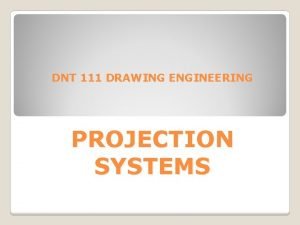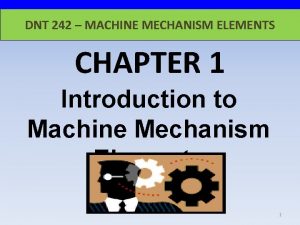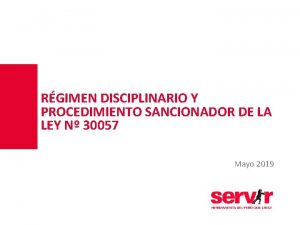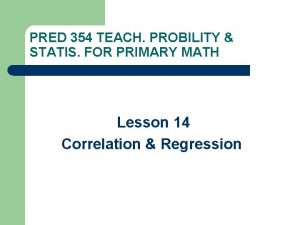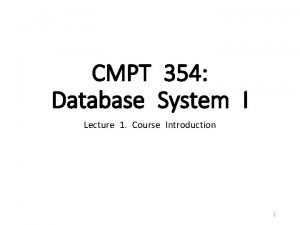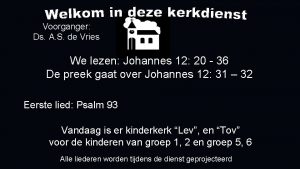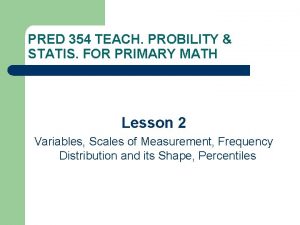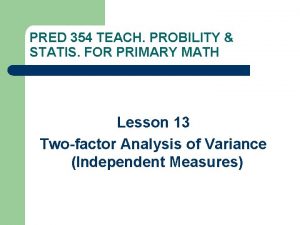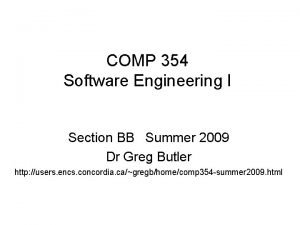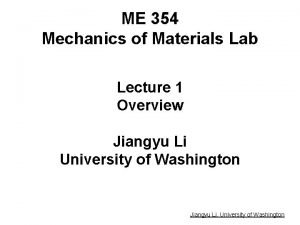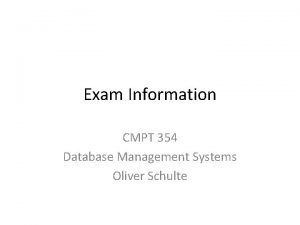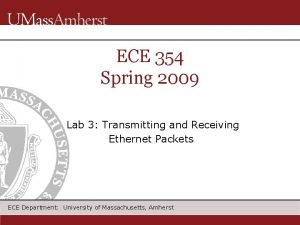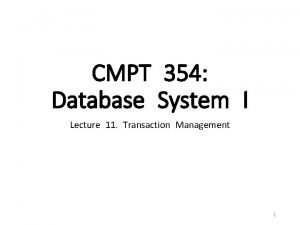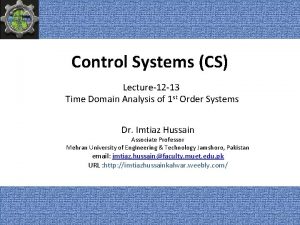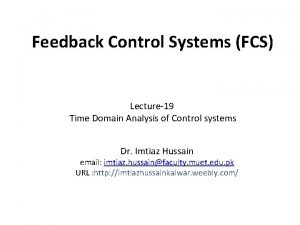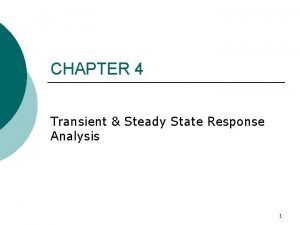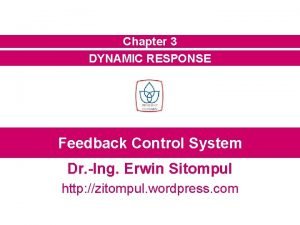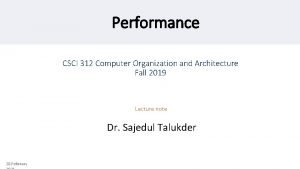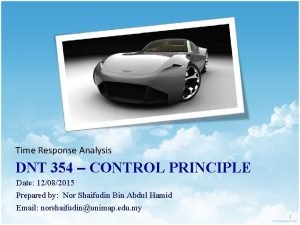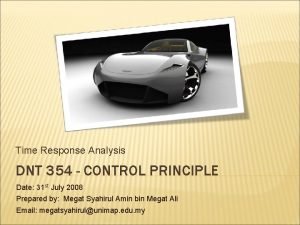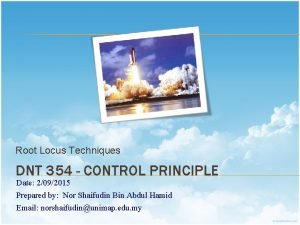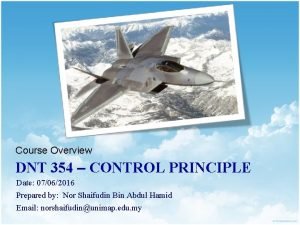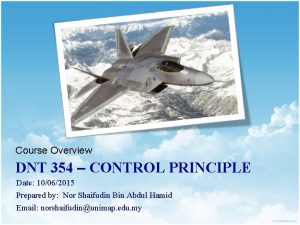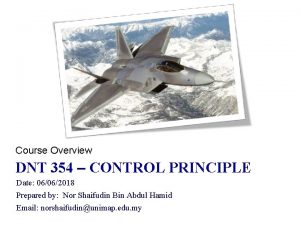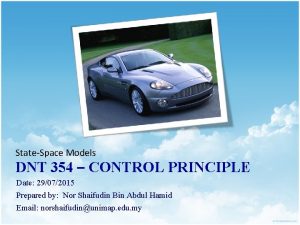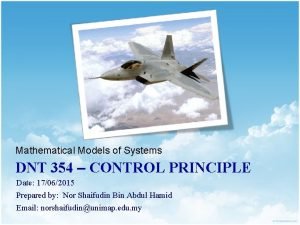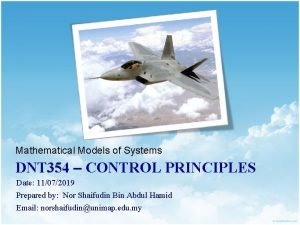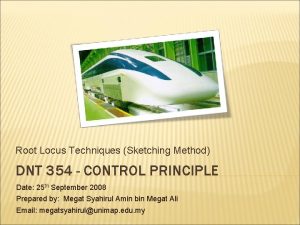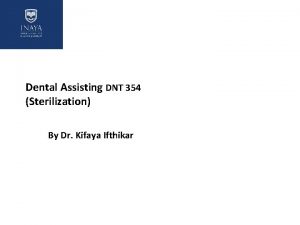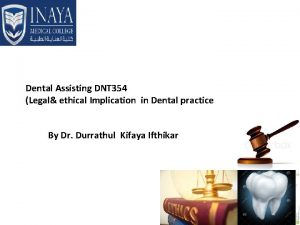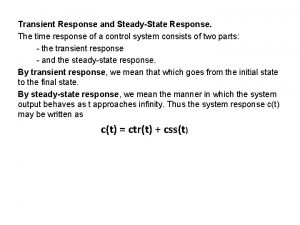Time Response Analysis DNT 354 CONTROL PRINCIPLE Date



































- Slides: 35

Time Response Analysis DNT 354 – CONTROL PRINCIPLE Date: 25/07/2017 Prepared by: Nor Shaifudin Bin Abdul Hamid Email: norshaifudin@unimap. edu. my 1

CONTENTS Introduction Influence of Poles on Time Response Transient Response of First-Order System Transient Response of Second-Order System 2

INTRODUCTION The concept of poles and zeros, fundamental to the analysis of and design of control system, simplifies the evaluation of system response. The poles of a transfer function are: i. ii. Values of the Laplace Transform variables s, that cause the transfer function to become infinite. Any roots of the denominator of the transfer function that are common to roots of the numerator. The zeros of a transfer function are: i. ii. The values of the Laplace Transform variable s, that cause the transfer function to become zero. Any roots of the numerator of the transfer function that are common to roots of the denominator. 3

INFLUENCE OF POLES ON TIME RESPONSE The output response of a system is a sum of i. ii. Forced response Natural response a) System showing an input and an output b) Pole-zero plot of the system 4

INFLUENCE OF POLES ON TIME RESPONSE c) Evolution of a system response. Follow the blue arrows to see the evolution of system component generated by the pole or zero 5

INFLUENCE OF POLES ON TIME RESPONSE Effect of a real-axis pole upon transient response a) First-order system b) Pole plot of the system 6

FIRST-ORDER SYSTEM General form: Problem: Derive the transfer function for the following circuit 7

FIRST-ORDER SYSTEM Transient Response: Gradual change of output from initial to the desired condition. Block diagram representation: R(s) C(s) Where, K : Gain : Time constant By definition itself, the input to the system should be a step function which is given by the following: 8

FIRST-ORDER SYSTEM General form: Output response: 9

FIRST-ORDER SYSTEM Problem: Find the forced and natural responses for the following systems 10

FIRST ORDER SYSTEM First-order system response to a unit step 11

TRANSIENT RESPONSE SPECIFICATIONS Time constant, Rise time, tr The time for e-at to decay 37% of its initial value. The time for the waveform to go from 0. 1 to 0. 9 of its final value. Settling time, ts The time for the response to reach, and stay within 2% of its final value. 12

TRANSIENT RESPONSE SPECIFICATIONS Problem: For a system with the transfer function shown below, find the relevant response specifications i. iii. Time constant, Settling time, ts Rise time, tr 13

SECOND-ORDER SYSTEM General form: Where, K : Gain ς : Damping ratio n : Undamped natural frequency Roots of denominator: 14

SECOND-ORDER SYSTEM Natural frequency, n Frequency of oscillation of the system without damping. Damping ratio, ς Quantity that compares the exponential decay frequency of the envelope to the natural frequency. 15

SECOND-ORDER SYSTEM Problem: Find the step response for the following transfer function Answer: 16

SECOND-ORDER SYSTEM Problem: For each of the transfer function, find the values of ς and n, as well as characterize the nature of the response. a) b) c) d) 17

SECOND-ORDER SYSTEM 18

SECOND-ORDER SYSTEM 19

SECOND-ORDER SYSTEM Step responses for second-order system damping cases 20

SECOND-ORDER SYSTEM Pole plot for the underdamped second-order system 21

SECOND-ORDER SYSTEM Second-order response as a function of damping ratio 22

SECOND-ORDER SYSTEM Second-order response as a function of damping ratio 23

SECOND-ORDER SYSTEM When 0 < ς < 1, the transfer function is given by the following. Where, Pole position: 24

SECOND-ORDER SYSTEM Second-order response components generated by complex poles 25

SECOND-ORDER SYSTEM Second-order underdamped responses for damping ratio value 26

TRANSIENT RESPONSE SPECIFICATIONS Second-order underdamped response specifications 27

TRANSIENT RESPONSE SPECIFICATIONS Rise time, Tr from 0. 1 to 0. 9 of its Peak time, Tp The time for the waveform to go final value. The time required to reach the first or maximum peak. Settling time, Ts The time required for the transient’s damped oscillation to reach and stay within ± 2% of the steady-state value. 28

TRANSIENT RESPONSE SPECIFICATIONS Percent overshoot, %OS The amount that the waveform overshoots the steady-state, or final value at peak time, expressed as a percentage of the steady-state value. 29

SYSTEM PERFORMANCE Percent overshoot versus damping ratio 30

SYSTEM PERFORMANCE Lines of constant peak time Tp, settling time Ts and percent overshoot %OS Ts 2 < Ts 1 Tp 2 < Tp 1 %OS 1 < %OS 2 31

SYSTEM PERFORMANCE Step responses of second-order underdamped systems as poles move a) With constant real part b) With constant imaginary part 32

SYSTEM PERFORMANCE Step responses of second-order underdamped systems as poles move c) With constant damping ratio 33

FURTHER READING… Textbook i. Norman S. Nise : Control System Engineering-5 th Ed. , John Wiley & Sons, 2008. References ii. iv. Ogata, Katsuhito : Modern Control Engineering-5 th Ed. , Prentice Hall, 2010. Richard C. Dorf & Robert H. Bishop : Modern Control Systems -11 th Ed. , Prentice Hall, 2008. Franklin G. F. , Power J. D & Emami-Naeini A. : Feedback Control of Dynamic Systems -6 th Ed. , Addision Wesley, 2009. 34

THE END… 35
 Dnt frivillig arbeid
Dnt frivillig arbeid Dnt drawing
Dnt drawing Dnt machine
Dnt machine Dnt travsport
Dnt travsport Dnt computer
Dnt computer Dividend payment
Dividend payment Ex dividend date
Ex dividend date Informe técnico 354-2019-servir/gpgsc
Informe técnico 354-2019-servir/gpgsc Informe técnico 1005-2018-servir-gpgsc
Informe técnico 1005-2018-servir-gpgsc Time bound promotion
Time bound promotion Pred 354
Pred 354 Glorie aan god
Glorie aan god Piazza sfu
Piazza sfu Opwekking 354
Opwekking 354 354
354 Math pred
Math pred Pred 354
Pred 354 Comp 354
Comp 354 Art 354 kc
Art 354 kc Me 354
Me 354 Cmpt 354
Cmpt 354 Ece 354
Ece 354 Cmpt 354
Cmpt 354 Augustine 354-430 ad
Augustine 354-430 ad Natural response and forced response
Natural response and forced response What is natural response
What is natural response Primary immune response and secondary immune response
Primary immune response and secondary immune response Elapsed time
Elapsed time Time domain analysis of control system
Time domain analysis of control system Telling time and date
Telling time and date Date, time venue invitation
Date, time venue invitation Qrqc board
Qrqc board The impulse signal imitate the
The impulse signal imitate the Transient and steady state response
Transient and steady state response What is dynamic response in control system
What is dynamic response in control system Decreasing response time almost always
Decreasing response time almost always

